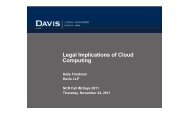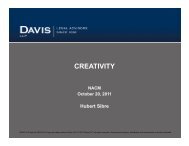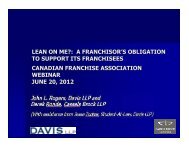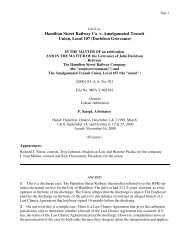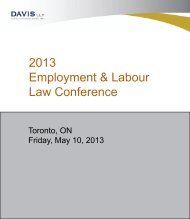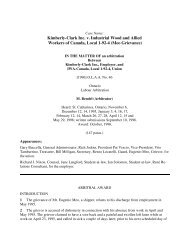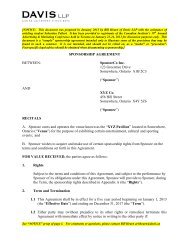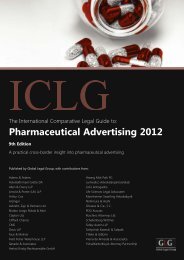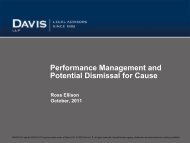Download PDF - 169 kb - Davis LLP
Download PDF - 169 kb - Davis LLP
Download PDF - 169 kb - Davis LLP
- No tags were found...
You also want an ePaper? Increase the reach of your titles
YUMPU automatically turns print PDFs into web optimized ePapers that Google loves.
It’s Not Just What You Do, But HowYou Do It:Procedural vs. Substantive Aspects of the Duty toAccommodateIngrid OttoOctober, 2011DAVIS <strong>LLP</strong> and the DAVIS <strong>LLP</strong> logo are trade-marks of <strong>Davis</strong> <strong>LLP</strong>, © 2007 <strong>Davis</strong> <strong>LLP</strong>, all rights reserved. Unauthorized copying, distribution and transmission is strictly prohibited.
Duty to Accommodate• Objective: Identify how to meet the duty toaccommodate and limit liability (and save $).• What is the content of the procedural aspect ofthe duty to accommodate?-1-
Duty to Accommodate• The “duty to accommodate” is a human rightsobligation, implied by law.• Duty is not found in human rights statutes; it arisesfrom decisions of the Court:“The duty to accommodate in the workplace arises when anemployer seeks to apply a standard that is prejudicial to anemployee on the basis of specific characteristics that areprotected by human rights legislation. This can occur in thecontext of a sick employee’s right to be absent from work … orof a similarly protected right, such as a woman’s right to beabsent from work owing to pregnancy.”McGill University Health Centre (2007, SCC)-2-
Duty to Accommodate• When does the “duty to accommodate” arise?• First step is to determine whether the standardbeing applied has the effect of being prejudicialto the employee on the basis of a protectedground under human rights legislation. (e.g.return to work for disabled employee).• Not every distinction or every adverse effect isdiscriminatory: the key is that there must be alink between the disadvantaging criterion orconduct and the disability.McGill University Health Centre (2007, SCC)-3-
Duty to Accommodate• How do you tell if a standard is discriminatory:• Three part test in which the complainant must prove:• He/she had or was perceived to have a disability (or someother protected ground)• He/she received adverse treatment• His/her disability (or other protected ground) was a factor inthe receipt of the adverse treatment)CEP v. Domtar Inc. (2009, BCCA)• It must be reasonable to infer that disability was a factor(but doesn’t need to be the overriding factor).Kemess Mines Ltd. v. IUOE, Local 115 (2006, BCCA)-4-
Duty to Accommodate• Once a case of discrimination is established, an employermay justify the standard by establishing that:• The employer adopted the standard for a purpose rationallyconnected to the performance of the job;• The employer adopted the particular standard in an honest andgood faith belief that was necessary to the fulfillment of alegitimate work-related purpose; and• The standard is reasonably necessary to the accomplishment ofthe legitimate work-related purpose and it is impossible toaccommodate the complainant (or the individuals sharing thecharacteristics of the complainant) without imposing unduehardship upon the employer.British Columbia (Public Service Employee Relations Commission v. BCGSEU,(1999, SCC) “Meiorin test”-5-
Duty to Accommodate• When considering whether a standard is “reasonablynecessary” an adjudicator may consider the proceduraland substantive aspects of the employer’s decisionseparately:• The procedural aspect of the employer’s decision includes aconsideration of whether the employer has made anindividualized assessment of the employee’s needs, anadequate assessment of potential accommodation measuresand tailored the approach accordingly.• The substantive aspect refers to a consideration of thereasonableness of the actual accommodation being offered (ornot offered) and the employer’s reasons.Meiorin; Scarlett v. Hamilton Health Sciences Corporation (2011, HRTO)-6-
Content of the Procedural Aspect of theDuty to Accommodate• Some considerations of the procedural aspects of theemployer’s duty to accommodate and the adequacy ofthe employer’s deliberation process include:• Who was involved in the original deliberations and thedecisions in the accommodation request?• What options for accommodation were considered?• Did the employer seek to identify options that theemployee did not raise? (Based on the assumption thatthe employer is better positioned to do so given itsknowledge of its business operations.)-7-
Content of the Procedural Aspect of theDuty to Accommodate• Was sufficient effort made to solicit the views of theemployee requesting accommodation?• If the employer opposes an accommodation on thegrounds that it might impinge on other legal requirements– did it take sufficient steps to obtain independent expertadvice (e.g. legal advice, advice from relevant governmentand regulatory agencies, etc.).Datt v. McDonald’s Restaurants of Canada (2007, BCHRT)-8-
Case #1: Peter• Is the procedural aspect of the duty toaccommodate a separate obligation? What is thecontent of that obligation?• Employee is a part-time paramedic for the BCAmbulance Service (“BCAS”).• Has MS which causes him to lose sensation in hishands.• Spring, 2004 – Peter cannot palpate pulses – has torely on partner to do so.• Robin, Peter’s Unit Supervisor, tells other attendantsto assist Peter.-9-
Case #1: Peter• Employer obtains medical opinion that Peter can doall of job except palpation of pulses. A suggestionto obtain a technical aid is not followed up on byemployer.• April & May, 2005 – Doug becomes RegionalManager and suspends Peter from work when Douglearns he can’t palpate.• BCAS obtains further medical opinions whichconfirm Peter can do job except he cannot palpate apulse.• Doug interviews Peter’s co-workers who expressedconcerns about Peter’s inability to feel steeringwheel, his inability to tell how hard he was pressingon patients, etc. Peter’s condition has since improved.-10-
Case #1: Peter• Doug speaks with Peter about the concerns whoexplains that condition has improved and some ofthe information is outdated.• June, 2005 – Doug seeks advice from OH&SAdvisor; Peter is sent for a further IME with anOccupational Medicine specialist.• Specialist confirms Peter’s ability to work except topalpate a pulse which may be done with a technicalaid.• July, 2005 – Doug seeks further clarification fromIME physician about the use of the technical aid.-11-
Case #1: Peter• Doug contacts the Emergency Medical AssistantsLicensing Board (“EMALB”) to ask:• Whether Peter’s paramedic license could be continued.• What process is required to monitor his ability tomaintain his paramedic license.• Union suggests Peter return to work as a driveronly; Doug declines.• August, 2005 – Doug asks Peter to consent tofurther IME. Peter refuses and says BCAS is“opinion shopping”.-12-
Case #1: Peter• Doug gets IME based on generalized informationprovided to physician. IME narrows issues down to:• Is the ability to palpate a pulse a bona fiderequirement?• Is the use of a pulse oximeter (or other technicaldevice) a safe and acceptable substitute?• Bottom line recommendation of IME physician:given the concerns for patient safety, no changes bemade to present situation until further information isobtained.-13-
Case #1: Peter• September, 2005 – Union files grievance on behalf ofPeter alleging discrimination and unjust suspension.• June 2006 – Grievance is settled on basis that Peterwould work as a driver, but be paid as a paramedic.• Peter files a human rights complaint allegingdiscrimination by BCAS and Doug.• Result:• Tribunal hearing was 10 days long and involved 17witnesses including 5 expert witnesses on eachside.Cassidy v. Emergency Health and Services Commission and others (No. 2),(2008, BCHRT)-14-
Case #1: Peter• Tribunal Member found:• BCAS standard of requiring all paramedics to be able tomanually palpate pulses is reasonably necessary.• If this standard was not held to – BCAS would be requiredto lower the standard of care it provides to patients. Thiswould expose BCAS to an unacceptable risk of harm,which was contrary to the public interest as well as theinterests of individuals requiring its services.• Conclusion: Peter could not be accommodated to workas an attending paramedic without undue hardship toBCAS.• But….-15-
Case #1: Peter• But, Tribunal Member also found:• BCAS and Doug did not treat Peter fairly and withdue respect to his dignity throughout theaccommodation process and this was a breach ofthe procedural aspect of the duty to accommodate.• Doug should have seen Peter and in person and beenmore sensitive when he suspended Peter in May, 2005.• Treating Peter’s limitations as an Occupational Healthand Safety Hazard was unusual protocol (attributed toDoug’s inexperience as a manager). This wasdemeaning to Peter.-16-
Case #1: Peter• Peter’s front-line supervisor spread misinformationabout Peter’s condition to staff.• BCAS could have been more diligent about returningPeter to the workplace (especially as he was withoutincome), and could have placed him as a driver sooner.• BCAS took active steps to have Peter’s paramediclicense revoked (although the Tribunal recognized itwas entitled to do so).• But…-17-
Case #1: Peter• It doesn’t end here…:• The BC Supreme Court overturned the Tribunal decision andconcluded:• It was an error in law to consider whether BCAS treated Peter“fairly and with due respect for his dignity, throughout theaccommodation process”.• The question should have been whether BCAS reasonablyaccommodated Peter, including whether it ought to havepermitted him to work in some other position earlier than it did,or whether it would have been undue hardship to do so.• There is no separate procedural duty that can be breached: thesingle question is whether an employer can accommodate theemployee without experiencing undue hardship.Emergency Health and Services Commission v. Cassidy (2011, BCSC)-18-
Case #1: Peter• Other learning points:• Gather information from reliable and appropriate sources(employee sources are inherently risky) and weighinformation appropriately.• Seek advice where appropriate (independent medicaladvice, regulatory agencies, legal advice).• Define the issues as early as you can.• Act on information as early as reasonably possible (e.g.return to work possibilities).• Be prepared to defend decisions – ideally based onobjective evidence.-19-
Case #1: Peter• Control the dissemination of information by employees,managers and others.• Be prudent in your retention of medical experts.• Minimize delay in returning to work if reasonably possible.• Make decisions in good faith.• No separate procedural duty to accommodate - theultimate question remains the same: whether theemployer can accommodate the employee without unduehardship.-20-
Case #2: Lynda• Lynda started experiencing vision problems causedby cataracts.• Lynda had diminished ability to drive and read; bothwere vital components of her job as a medical salesrepresentative.• May 2000 – September 2002 – Lynda is totallydisabled and on disability leave.• September 2002 – Lynda learns her disabilitybenefits will terminate as she is deemed capable ofworking at some occupation. Her employer (BICL)becomes aware of this.-21-
Case #2: Lynda• November 2002 – Employer meets with LTD insurerand is told Lynda wants to return to work and thatLynda is working with LTD insurer to do so.Employer takes no steps to have Lynda return.• November 2002 onwards – Lynda is without income.• May 2003 – Lynda (with assistance from CNIB)advises employer that compromised ability to readand drive are possible through adaptive equipment;Employer does not follow up.• June 2004 – Employer requests Lynda providemedical information.-22-
Case #2: Lynda• July 2004 – Employer receives medical reportsuggesting Lynda is capable of returning to work.BICL does not act on this.• February 2005 – Employer sends Lynda a lettersuggesting medical information of July 2004 isinadequate and asks Lynda to fill out DisabilityAccommodation Questionnaire.• March 2005 – Lynda files human rights complaint.• April 2006 – Lynda arranges for expert assessmentswhich show she is physically capable of meeting jobrequirements with minimal restrictions.-23-
Case #2: Lynda• July 2006 – Employer relies on expert assessmentsand creates standard return to work plan for Lynda,but does not consult with Lynda first. The plan doesnot adequately address her restrictions andoverlaps with the time of the human rights hearing.• Employer argued at the Tribunal hearing that prior tothe medical report of July 2004, it had alwaysunderstood that Lynda was incapable of returning towork and had not received adequate rehabilitationassistance.• Employer also argued that the July 2004 report wasambiguous and so the delay in time was a result ofinternal inquires that needed to be made.-24-
Case #2: Lynda• Decision: Kerr v. Boehringer Ingelheim (Canada) No. 4(2009, BCHRT)• Tribunal hearing of 23 days spread out over two years.• Decision is rendered 4 years after the date of the originalcomplaint.• Tribunal concluded:• Employer knew, in November 2002, that Lynda wanted toreturn to work, but did not return her to work or start anyinquiry process to do so.• Employer’s return to work plan was deficient – did notadequately address her reading and driving restrictions.-25-
Case #2: Lynda• Conclusion: The steps that the employer took wereprocedurally deficient resulting in no substantiveresults for Lynda.• The employer unsuccessfully appealed thedecision and argued:• There was no discrimination; a failure to return anemployee to work simply because they say theywish to return is not discriminatory.• Lynda should have provided objective medicalevidence supporting her stated desire to return towork.-26-
Case #2: Lynda• Court said No: Onus/responsibility is not onemployee to figure out whether she can return towork and what she can do.• Employer is better positioned to understand duty toaccommodate and available opportunities.• In this case, where employer was aware that Lyndacontinued to drive, read and write (although not aswell as before), onus was on employer to assessthose skills as part of accommodation assessment.Boehringer Ingelheim v. Kerr (2010, BCSC)-27-
Case #2: Lynda• The employer unsuccessfully appealed that decision tothe Court of Appeal, again arguing: a mere request towork and refusal is not discrimination.• Court of Appeal disagreed: Lynda’s visual impairmentwas a factor in the employer’s delay in returning her towork – this was discrimination.• Implicit in a stated desire to return to work is a subjectivebelief one can work – Employer is reasonably expected toseek clarification as to employee’s actual condition and tofail to do so is arbitrary and discriminatory conduct.Boehringer Ingelheim v. Kerr (2011, BCCA)-28-
Case #2: Lynda• Other learning points:• Consult with employee throughout process.• Seek updates from employee as reasonably needed.• Act on changed information and/or seek clarificationwhere reasonably required.• Be cautious of non-current information or assumptions.• Be reasonably responsive to employee input.• Tailor the solution to the employee’s individualizedcircumstances.• Minimize delay in returning to work if reasonably possible(and be prepared to explain delays).-29-
Case #3: Teresa• Fire inspector with City of Richmond.• March 2007 – commences sick leave and diagnosedwith PTSD.• Prognosis to return to work is poor becausecondition is characterized as “reactive depression”related to “work place stressors”.• June 2008 – employer tells Teresa paid sick leave isending – seeks medical information concerning RTWor continued leave.-30-
Case #3: Teresa• September 2008 - Teresa’s medical certificate says“Permanently unable to work at workplace”;suggests retraining.• September 2008 - employer meets with Teresa andrequests resume to facilitate search for otherpositions.• October 2008 - employer seeks clarification fromphysician (repeatedly) on medical certificate.• Teresa’s physician says no return to fire departmentever; can return to non-fire department position inthe future.-31-
Case #3: Teresa• November 2008 - employer receives informationfrom Teresa’s psychologist - recommendation:Teresa requires work in a “non-male-dominatedcollaborative and collegial workplace”.• December 2008 - employer seeks information fromTeresa’s counsellor to provide input on RTW.• Employer permanently fills Teresa’s position.• Employer searches for position for Teresa thatmeets parameters of medical / counsellor’s advice.-32-
Case #3: Teresa• August 2009 - employer offers Building ServicesWorker position and offers to retrain Teresa.• Teresa asks to defer decision until her WCATdecision reached.• Employer only agrees to delay if she accepts offer;otherwise, must search for other positions.• Teresa rejects Building Services Worker position.-33-
Case #3: Teresa• January 2010 - WCAT rejects Teresa’s claim.• February 2010 - employer seeks updated medicalinformation and resume from Teresa.• February 2010 - Teresa says can’t respond until midMarch.• March 2010 - employer sends Teresa a letterreminding of duty to cooperate in accommodationprocess.• March/April 2010 - Teresa submits medicalcertificate. She has redacted some of her doctor’scomments.-34-
Case #3: Teresa• April 2010 - employer continues to assess positionsfor Teresa.• May 2010 - Teresa submits letter from psychologistregarding RTW possibility at fire hall. Employerrejects as not viable – does not accurately reflectwork environment.-35-
Case #3: Teresa• May 2010 - employer makes another offer of anotherBuilding Services Worker position.• June 2010 - Teresa rejects offer of “menialemployment” which is below her qualifications andabilities.• June 2010 - employer terminates Teresa’semployment.• Teresa files human rights complaint.-36-
Case #3: Teresa• Result: Rush v. Richmond (City), (2011, BCHTR)• Employer met duty to accommodate.• Accommodated absence for over three years.• No requirement to hold a position open indefinitely.• Employer’s efforts to secure medical informationand other information were reasonable.• Employer gave Teresa second chances when shewas not responsive.• Delays were caused by Teresa; employer reasonablyextended deadlines.-37-
Case #3: Teresa• Employer not discriminating by only consideringvacant available positions (especially in time ofbudget restraint).• Employer was entitled to terminate after secondrefusal of accommodation solution.• Conclusion: Teresa was offered reasonableaccommodation and cannot expect a perfect solution.Employer met duty to accommodate to point of unduehardship.-38-
Case #3: Teresa• Other Learning Points:• Seek medical and other required information (e.g.resume).• Follow through on requests for information wheninformation provided is inadequate/ not responsive.• Give second chances to employee when reasonable to doso.• Tailor the accommodation solution to the employee’sindividualized circumstances (defining the parameters ofthe accommodation).• Be proactive in search for options (“build the case”).• Put employee on notice of duty to cooperate and tofacilitate accommodation.-39-
Case #3: Teresa• Other Learning Points:• No obligation to hold a position open indefinitely –especially where medical information indicates employeeunlikely to return.• Carry on with accommodation process where reasonableto do so– even where multiple proceedings may beoccurring.• Employee not entitled to a perfect solution - only areasonable accommodation that is not undue hardship.• Be prepared to defend decisions - ideally based onobjective evidence.-40-
Procedural Aspects of the Duty toAccommodate• Summary:• No separate procedural duty to accommodate, butapparent that the Tribunal and Courts will scrutinizethe process of accommodation closely.• So, once an employer is aware that accommodationmay reasonably be required, it is prudent to start“building the case” towards a tailoredaccommodation.• Employers can prove undue hardship, but need tobe (i) diligent in gathering objectively reliableinformation, (ii) reasonable in their collection andassessment of it; and (iii) patient – the process takestime, but is usually far less costly than litigation.-41-
Procedural Aspects of the Duty toAccommodateThank you!-42-



